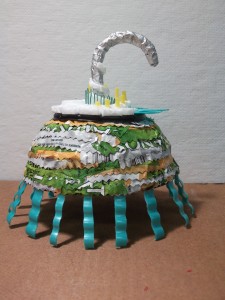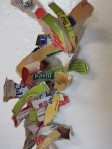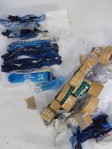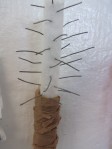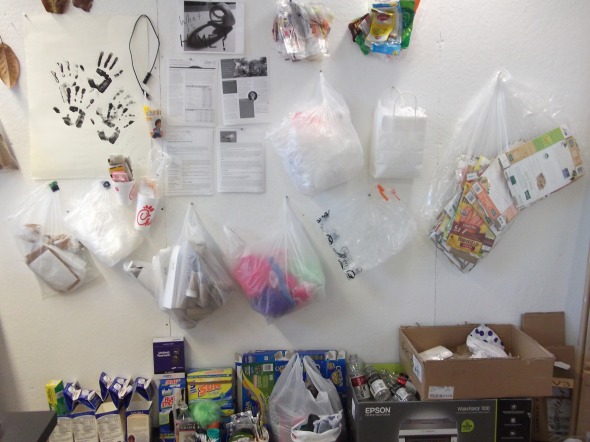I Believe
I was asked recently to give a short speech at a monthly event on campus about my beliefs. Because I am becoming more and more involved in environmental activism in my art I decided to talk about how I felt and what I believed about recycling and consumerism. Part of the speech was taken from a former post made during the course on three-dimensional thinking. I am posting my speech in its entirety, including the parts already posted on this blog, because I believe it sums up the direction I am taking quite well.
Grandmother. Grandma. Granny.
Meemaw…..
On or around January 10, I will be making yet another ‘rite of passage’ as a woman when my oldest daughter gives birth to my first grandbaby, and I can hardly wait. But this coming event has brought more than booties and bottles to the forefront of my mind. I am reflecting on the state of the environment of this great planet more than I ever have before. It’s not that I didn’t care when my daughters were born so many years ago. In fact, my oldest daughter was only 6 months old when, in March 1979, there was a serious accident at the Three Mile Island nuclear power plant in Pennsylvania. I have not forgotten the fear of waiting for news that could tell us exactly what was happening. After the worst was presumably over I learned more about the environment and pollution. Like many, I began to recycle and reuse, hoping to decrease my global footprint. But over the years my attention turned more and more to the daily hassles of life and I began to pay less notice to news about the environment. When I did hear anything about pollution or landfills I felt smug in the knowledge that I recycled. I also paid little attention to my buying habits as well, which grew in proportion to my income. I did, after all, recycle. If you asked me exactly what that meant all I could tell you was that I deposited certain types of materials into the appropriate containers every week. As far as I was concerned, I was golden.
This past spring I enrolled in Three Dimensional Thinking, a sculpture class taught by Nell Ruby. One of our class assignments involved collaboration with the Office of Sustainability on individual projects using recyclable material. This one project has grown to become the center of my artist statement and the focus of my senior seminar as I learned more and more about the state of our environment, both here and around the world, and the connection to consumer culture. For instance, I did not know that more than 250 Million tons of waste, are generated annually in the U.S. Or that out of this refuse, only about 30% is actually recycled, leaving approximately 175 million tons of waste to be dumped into landfills. Or that plastic is made from the by-products of oil after the octane is removed for fuel. And I knew absolutely nothing about the impact on the environment or the communities and people within and around the areas where oil is taken from the earth.
A walk through a local “Big Box” store provided more insight into the consumer connection. Shelf after shelf of cheap items made mostly out of plastic and marketed to get my attention. It’s no wonder a single trip to Walmart to buy a roll of masking tape can easily result in a basket full of items, mostly junk, that will ultimately end up in the trash. As a consumer I am “consumed” by the idea of “more is better”. And while having more stuff may make me feel better for a moment, more IS NOT better for my environment. Although I recycle as much as possible and I re-use or find new uses for items no longer serving their original purpose, there is still a limit to what can actually be recycled. So I wondered if I could re-train my brain to want less. I decided it might be time for some retail therapy in my life. The 12 steps of recovery, which originated with the founders of Alcoholic Anonymous, have proven very useful as tools for changing harmful behaviors. On a whim, I applied them to consumer habits.
- Step 1: Admitted I was powerless over big-box stores, that my plastic consumption had become unmanageable.
- Step 2: Came to believe that “green” knowledge could restore me to sanity.
- Step 3: Became willing to turn my buying habits over to the idea that less REALLY IS more.
- Step 4: Made a searching and fearless personal “trash inventory” of the stuff I throw away.
Okay now, step 4 was really revealing. In one week my household (myself and one 10 yr. old child) accumulated three bags of material for recycling! Suddenly, all of my ongoing efforts to recycle shrank in comparison to the larger picture of this amount of trash multiplied by 52 weeks.
- Step 5: Admitted to myself, to my spirit, and to anyone who will listen, that over-consumption is in my nature.
- Step 6: Was entirely convinced I needed to change the way I “consume” the earth’s resources.
- Step 7: Humbly began to approach reduced consumption as a means to help save my planet from destruction.
- Step 8: Made a list of all the ways I can reduce and reuse.
- Step 9: Began to reduce my unnecessary consumption whenever and wherever possible.
- Step 10: Continued to take “trash inventory” and promptly adjust my consumption as needed.
- Step 11: Sought through research to improve my conscious understanding of eco-friendly principles and meditated for the power to carry them out in my daily life.
- Step 12: Having had a spiritual reality check as a result of these steps, I will try to promote the idea of consumer accountability by setting an example and practicing eco-friendly principles everyday.
As it turned out, these steps are more serious than playful when I think in terms of what my children’s children will inherit. Although the task may seem daunting when viewed as a whole, I still believe that what I do as one single person really does have an impact on the big picture. By living more responsibly as a consumer I can reduce my impact on the planet and encourage others by setting an example. I taught my daughters to love and respect the environment. One day soon I will continue that legacy with my grandson.
Shelters
These are some “shelters” I have created using trash and a bit of whimsy.
I have to be careful to stay unattached and in the process or I end up overworking the idea. Then it becomes about me and not the formal qualities I’m trying to learn. And I end up with junk. Sometimes it’s cute junk, but still…
Trash In Trash Out?
When I first approached this project, I was excited about the vision I had for the outcome.
These are nothing like what I first had in mind.
Somewhere along the way I fired my brain and got busy with the job of creating art for the sake of art.
I truly hope these are living up to those last words because I love them so much.
No Brain Imposition
I have been increasingly frustrated with my attempts to make something happen with all this trash. First I thought I wanted to convey a sense of the day-to-day reality for people living in developing areas of the world, like the Amazon rainforests in Ecuador, where over 30 years of pollution caused by toxic oil spills into the water and on the land of their villages threatens their existence. Nell suggested I make a number of sketches of their homes to begin…..
I really like these drawings. So much so that when I started trying to create them with trash I could not let go of their inherent nature and make anything happen.
That phrase….make happen…..
Trying to make it happen.
Force.
Will.
Trying to impose my will.
My concept.
My precious concept. (my presssciousssss…)
%$&#!
The suggestion to give up the fight and give into the process yielded 2 hours of unguided exploration into what these unfamiliar materials would actually or could actually do.
The results made me very happy!
Surrender is so peaceful…….
Trash Galore!
I have been collecting recyclable and non-recyclable material throughout the summer in preparation for my senior seminar this fall. I unpacked everything in my studio……
and stepped back to absorb the mess…
So I did some obsessive sorting and ended up with what Victoria calls my palette….
Inspiration
I googled ‘upcycling’ to find these images….
Old chairs made new.
Plastic cups.
This first prize winner is an old photo, hand-painted and mounted on a paper shopping bag.
Toilet paper and paper towel rolls.
Tax forms and political junk mail.
Tires. In case you couldn’t tell.
Box cars and other vehicles.
I’m stoked!
Nietzsche’s Eye’s
“I teach you the overman. Man is something that shall be overcome. What have you done to overcome him? … All beings so far have created something beyond themselves; and do you want to be the ebb of this great flood, and even go back to the beasts rather than overcome man? What is ape to man? A laughing stock or painful embarrassment. And man shall be that to overman: a laughingstock or painful embarrassment. You have made your way from worm to man, and much in you is still worm. Once you were apes, and even now, too, man is more ape than any ape…. The overman is the meaning of the earth. Let your will say: the overman shall be the meaning of the earth…. Man is a rope, tied between beast and overman—a rope over an abyss … what is great in man is that he is a bridge and not an end.”
Okay.
Studio Space Rocks!!!!!!
Can I just say that having a studio in Dana is so cool!
Getting to hang out and work with other artists is really good fertilizer for the creative garden. I’m so happy for this chance to learn and grow.
Responsible Community
“Anything can be art, all you have to do is change your mind.” ~ John Cage
Finding this quote in a book about the artist John Cage reminded me of the ‘trash project’ in 3-D thinking spring semester. When I began collecting my recyclable trash for that project, I was amazed at the amount quickly accumulated. Magnified billions of times around the world felt suffocating (I’m a very visual thinker). Over the summer I read, surfed, and watched many documentaries not only about trash and ecology, but also concerning the areas of the world that have been ‘harvested’ of their natural resources…. always at the detriment of the people who occupied the land within the countries from which these resources were taken. Corporations that saw HUGE profits without having to return much to the people have been negligent, often criminally, leaving the people with consequences of extraction processes that left their homeland so polluted they were contaminated with carcinogens or forced to leave their already impoverished existence and try to start over. The policies of these companies have not evolved and there is continued destruction. Three questions have been haunting me…
Where does it lead?
Where does it end?
When is it going to be too late?


